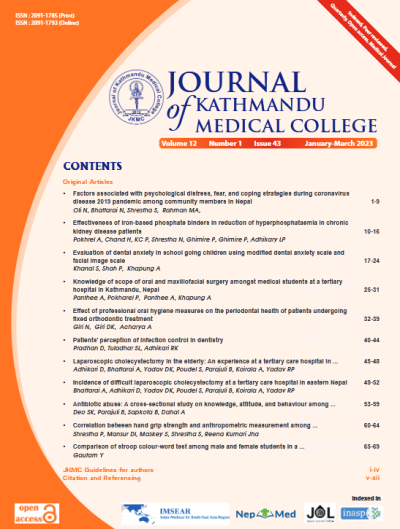Comparison of stroop colour-word test among male and female students in a medical college of Nepal
DOI:
https://doi.org/10.3126/jkmc.v12i1.56695Keywords:
Medical students, Reaction time, Stroop colour-word testAbstract
Background: The Stroop Colour-Word Test is a widely used neuropsychological test. This test is designed to assess impaired concentration and the struggle to stay focused despite of distractions. There are conflicting data on the gender difference in Stroop test.
Objectives: To make a gender comparison of the reaction time by Stroop Colour-Word Test in young healthy medical students.
Methods: This was a cross -sectional analytical study conducted at the Department of Physiology, Kathmandu University School of Medical Sciences from 2022 August to 2022 October. Stroop Color Word test was done in healthy medical students with three different cards, a control card (colour word written in black color), congruent card (colour word written in same color as written word) and incongruent card (colour word written in different colour then word written). The number of errors made and reaction time was noted. Paired t-test was applied. Gender comparison was made and independent sample t-test was done.
Results: Out of total 130 participants, 68 were females and 62 were males. The number of errors made was 0,0 and 12.8 ± 2 and the reaction time was 38.3 ± 2.3, 37.2 ± 2.8 ,72.5 ± 5.6 seconds for control, congruent and incongruent card respectively which was statistically significant for incongruent card. There was no significant difference between males and females.
Conclusion: Reaction time by Stroop Colour-Word Test is longer for incongruent words. There is no gender difference in errors made or reaction time in Stroop Colour-Word Test.
Downloads
Downloads
Published
How to Cite
Issue
Section
License

This work is licensed under a Creative Commons Attribution-NonCommercial 4.0 International License.
Copyright © Journal of Kathmandu Medical College
The ideas and opinions expressed by authors or articles summarized, quoted, or published in full text in this journal represent only the opinions of the authors and do not necessarily reflect the official policy of Journal of Kathmandu Medical College or the institute with which the author(s) is/are affiliated, unless so specified.
Authors convey all copyright ownership, including any and all rights incidental thereto, exclusively to JKMC, in the event that such work is published by JKMC. JKMC shall own the work, including 1) copyright; 2) the right to grant permission to republish the article in whole or in part, with or without fee; 3) the right to produce preprints or reprints and translate into languages other than English for sale or free distribution; and 4) the right to republish the work in a collection of articles in any other mechanical or electronic format.




